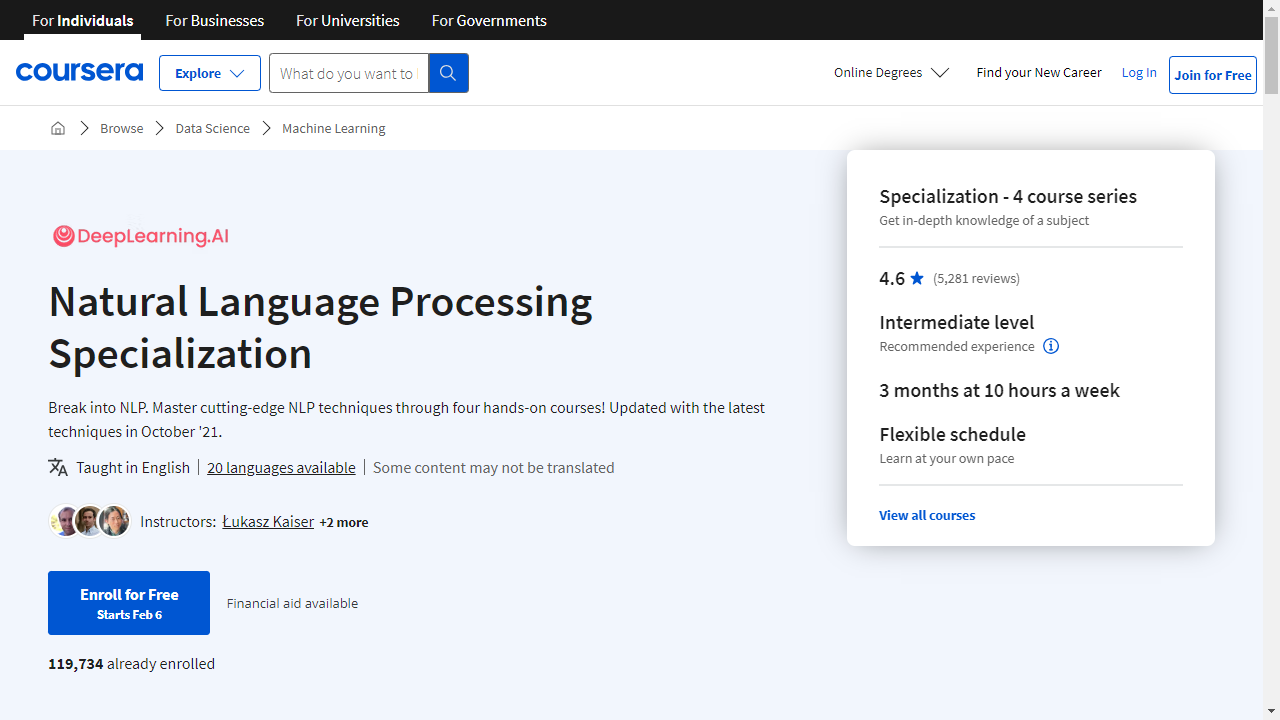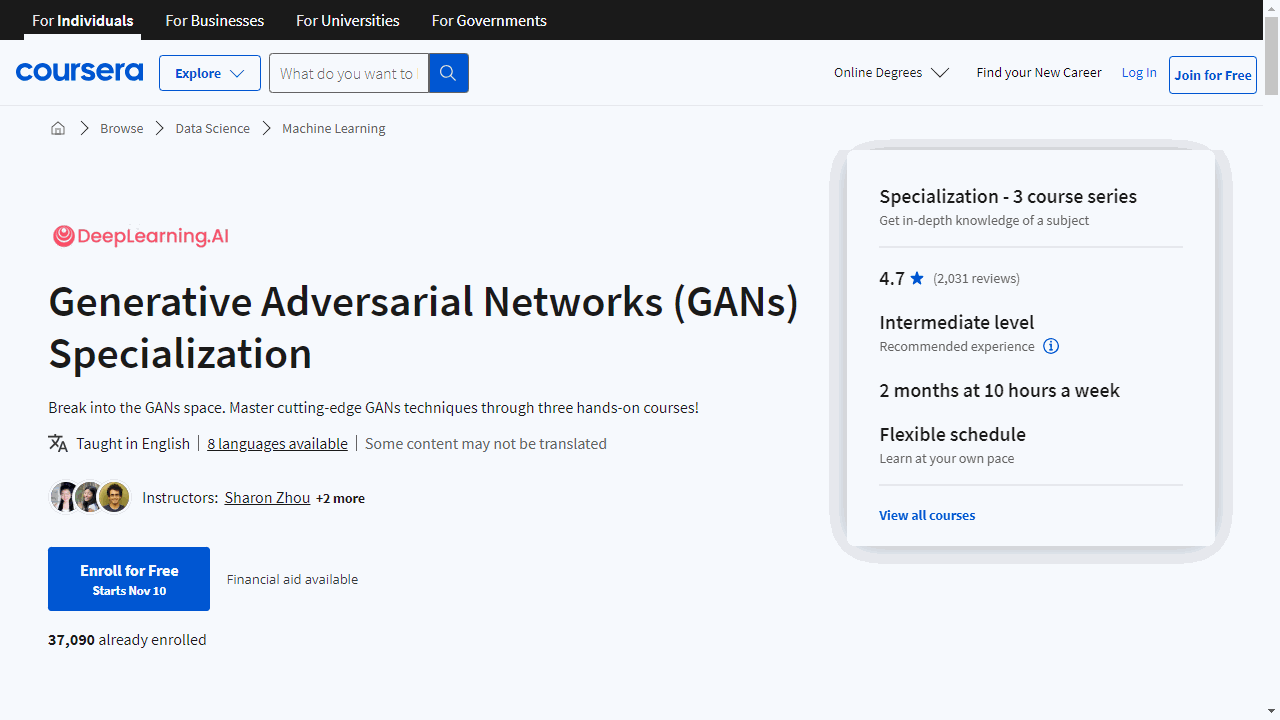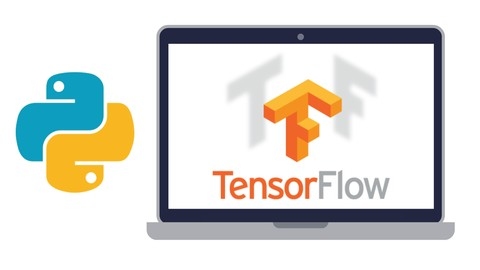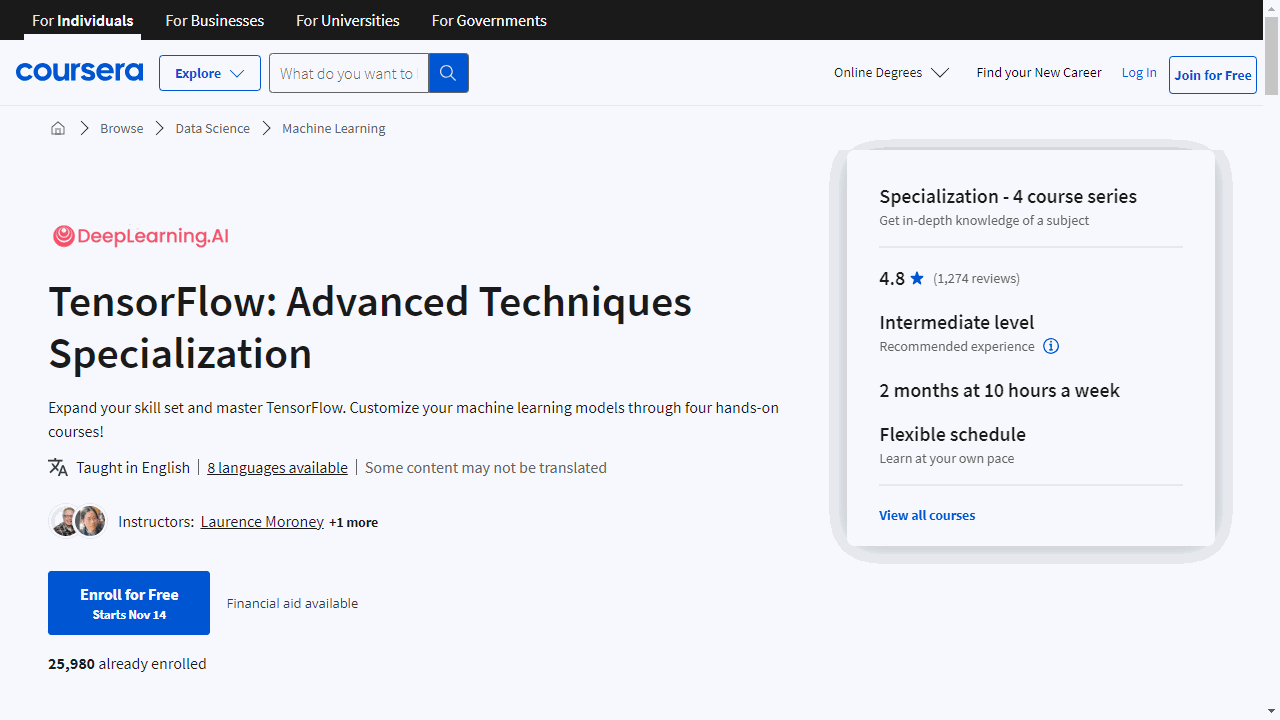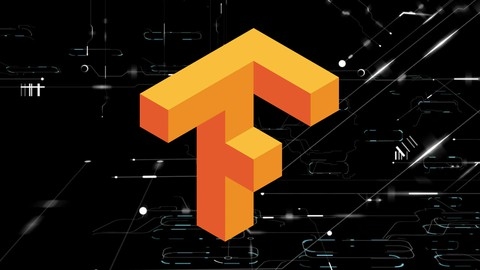Deep learning, a subfield of artificial intelligence, focuses on training artificial neural networks with vast amounts of data to enable them to learn and make intelligent decisions.
It’s revolutionizing industries like healthcare, finance, and autonomous driving by powering applications like image recognition, natural language processing, and fraud detection.
By mastering deep learning, you gain the ability to build innovative solutions, contribute to cutting-edge research, and unlock a world of exciting career opportunities in the ever-evolving field of AI.
Finding the perfect deep learning course can be a daunting task, given the abundance of options available online.
You’re searching for a course that not only provides a strong theoretical foundation but also equips you with practical skills and hands-on experience through engaging projects and real-world applications.
You want a course that caters to your learning style, whether you prefer in-depth lectures, interactive exercises, or a combination of both.
Based on our comprehensive review of various deep learning courses, we highly recommend the Deep Learning Specialization on Coursera as the best overall option.
Developed by Andrew Ng, a renowned expert in AI, this specialization offers a comprehensive and well-structured curriculum that covers a wide range of deep learning concepts, from foundational neural networks to advanced techniques like convolutional and recurrent networks.
The course emphasizes practical application through hands-on projects and provides a solid foundation for building and deploying deep learning models.
However, we understand that the ideal course varies depending on individual preferences and learning goals.
Therefore, we’ve curated a list of other exceptional deep learning courses that cater to different needs and skill levels.
Whether you’re a beginner seeking a gentle introduction or an experienced practitioner looking to delve into specific deep learning frameworks or applications, you’ll find a course that suits you.
Deep Learning Specialization
Provider: Coursera
The Deep Learning Specialization on Coursera provides a comprehensive introduction to the world of deep learning, even if you are starting with no prior knowledge.
You will begin by mastering the fundamentals of neural networks and deep learning, learning how to build, train, and apply these powerful tools using TensorFlow.
You will gain practical experience in hyperparameter tuning, ensuring your deep learning models achieve optimal performance.
You will then explore techniques for improving deep neural networks, delving into the intricacies of regularization and optimization algorithms, such as momentum, RMSprop, and Adam.
This knowledge will equip you with the skills to build robust deep learning models and prevent overfitting, ultimately leading to higher model accuracy.
The specialization also emphasizes the importance of understanding the bigger picture when tackling machine learning projects.
You will develop the ability to diagnose errors in machine learning systems, prioritize strategies for improvement, and make critical decisions as a project leader.
You will also explore advanced techniques like transfer learning and multi-task learning, broadening your skillset and enabling you to solve increasingly complex problems.
Furthermore, you will dive into the exciting realm of computer vision, discovering how convolutional neural networks power applications like autonomous driving, facial recognition, and medical imaging.
You will learn how to build and apply these networks, gaining a deep understanding of their capabilities and limitations.
Finally, you will explore the fascinating world of sequence models, specifically recurrent neural networks (RNNs) like GRUs and LSTMs.
You will learn how to leverage these models for tasks such as machine translation, speech recognition, and natural language processing, preparing you for a future in this rapidly evolving field.
Deep Learning A-Z 2024: Neural Networks, AI & ChatGPT Prize
Provider: Udemy
In this course, you begin with the basics, gaining a solid understanding of what deep learning is, its history, and how it will shape the future.
You also learn how to leverage ChatGPT to enhance your deep learning journey.
The course then delves into the fascinating world of Artificial Neural Networks (ANNs), where you explore the structure of a neuron, the role of activation functions, and how these networks learn through concepts like gradient descent and backpropagation.
You then transition to Convolutional Neural Networks (CNNs), a powerful type of neural network designed for image recognition.
You uncover the inner workings of their architecture, from convolution operations and ReLU layers to pooling, flattening, and full connection.
You solidify your understanding by building a CNN, applying it to real-world image recognition tasks.
Next, you explore Recurrent Neural Networks (RNNs) and how they excel at handling sequential data like text and time series.
You learn about LSTMs, which address the vanishing gradient problem and effectively capture long-term dependencies in data.
You gain practical experience by building an RNN, putting your knowledge to the test with text analysis.
The course introduces you to Self Organizing Maps (SOMs), a unique type of neural network that provides a visual representation of complex data.
You deepen your understanding of clustering techniques like K-Means and explore how SOMs adjust their structure to learn from input data.
You then create your own SOM, gaining hands-on experience with this intriguing technique.
You then dive into the world of Boltzmann Machines, a fascinating type of neural network that utilizes an energy-based model for unsupervised learning.
You learn about Restricted Boltzmann Machines (RBMs) and Deep Belief Networks (DBNs), uncovering their ability to learn complex data representations.
You further solidify your understanding by building a Boltzmann Machine and evaluating its performance on real-world problems.
Finally, you explore AutoEncoders and their applications in dimensionality reduction and feature extraction.
You learn about various types, including Denoising Autoencoders and Stacked Autoencoders, and uncover how they effectively compress data.
The course guides you through building your own Autoencoder using PyTorch, opening doors to applications like anomaly detection and data compression.
Natural Language Processing Specialization
Provider: Coursera
This Natural Language Processing Specialization on Coursera equips you with the tools to build impressive, real-world NLP applications.
You will begin with foundational techniques like sentiment analysis, using logistic regression and naïve Bayes to determine the emotion behind a tweet.
You will then explore vector space models, understanding how words relate, and even build a basic English-to-French translation algorithm.
This journey through NLP continues as you delve into more complex concepts.
You will learn to build an autocorrect system using dynamic programming and the Viterbi Algorithm, essential for any language-based application.
You will also create a Word2Vec model, employing a neural network to decipher word meanings.
Prepare to dive deeper into neural networks, specifically recurrent neural networks, LSTMs, and GRUs.
You will use these to analyze sentiment, generate text like Shakespeare, and even recognize named entities.
You will discover how “Siamese Networks” compare different phrases to understand their underlying meanings.
Finally, you will explore the forefront of NLP with attention models.
You will build systems to translate English sentences into German, summarize text, and answer questions using powerful models like Transformers, T5, and BERT.
You will even create your own chatbot using a Reformer model.
This specialization, taught by experts from Stanford University and Google Brain, provides the knowledge and practical skills to excel in the dynamic world of NLP.
Deep Learning Prerequisites: The Numpy Stack in Python (V2+)
Provider: Udemy
In this course you’ll gain the essential skills needed to work with data in Python, a popular language for deep learning.
The course uses a hands-on approach with practical exercises, ensuring you can apply what you learn.
The course guides you through the fundamental libraries of the Numpy stack: Numpy, Matplotlib, Pandas, and Scipy.
You’ll start by learning how to manipulate data efficiently using Numpy arrays and matrices, performing calculations like dot products and solving linear systems.
You’ll then move on to data visualization with Matplotlib, mastering various plots like line charts, scatterplots, histograms, and even plotting images.
You’ll then explore Pandas, a powerful library for data analysis and manipulation.
You’ll learn how to load, filter, and select data from DataFrames, and perform operations like data aggregation and transformation.
Finally, you’ll delve into Scipy to work with probability distributions, convolutions, and other tools essential for advanced data analysis.
The course also introduces the basics of Machine Learning, including classification and regression, preparing you for further exploration in the field.
Generative Adversarial Networks (GANs) Specialization
Provider: Coursera
This GAN specialization on Coursera provides an exciting introduction to image generation with GANs.
You will begin by learning about GANs and their applications.
You will understand the intuition behind the fundamental components of GANs, such as the generator and discriminator.
You’ll explore and implement multiple GAN architectures, including DCGANs and WGANs, and build conditional GANs capable of generating examples from determined categories.
You’ll also learn to evaluate their performance using metrics like FID and address potential biases.
The specialization doesn’t stop at the basics.
You’ll dive into advanced GAN architectures like StyleGANs, known for producing high-quality images.
You will get hands-on experience using PyTorch, a popular deep learning framework, to train your own models and generate images.
You’ll explore conditional generation, a technique for creating images based on specific categories.
Finally, you’ll explore real-world applications of GANs, like data augmentation, privacy preservation, and image-to-image translation using techniques like Pix2Pix and CycleGANs.
For example, you’ll discover how to adapt satellite images into map routes and vice versa with Pix2Pix and transform horses into zebras (and vice versa) using CycleGANs.
Complete Guide to TensorFlow for Deep Learning with Python
Provider: Udemy
This Udemy course provides a complete guide to TensorFlow for deep learning using Python.
You will gain hands-on experience with essential libraries like NumPy, Pandas, and SciKit Learn.
TensorFlow, a powerful framework for building machine learning models, takes center stage in this course.
The journey begins with a crash course on machine learning fundamentals.
You will install TensorFlow, setting up your environment on either Windows, MacOS, or Linux.
You will then dive into TensorFlow basics, creating and running graphs, defining variables and placeholders, and building simple neural networks.
This foundation prepares you to explore convolutional neural networks (CNNs) for image classification and recurrent neural networks (RNNs) for natural language processing.
You will master advanced concepts like reinforcement learning, training agents to interact with environments using OpenAI Gym, and generative adversarial networks (GANs), which generate new data.
The course teaches you how to use TensorFlow’s built-in tools, such as TensorBoard, to monitor and visualize your training process, and introduces the Keras API for building complex models.
You will emerge from this course with a solid foundation in deep learning with TensorFlow, ready to build cutting-edge applications.
TensorFlow: Advanced Techniques Specialization
Provider: Coursera
This specialization on Coursera equips you with advanced techniques to build powerful deep learning models using TensorFlow.
You start by mastering the Functional API, a tool that gives you more control over your model’s architecture than the simpler Sequential API.
This lets you design complex models like Siamese networks, used for comparing images, and build custom loss functions, like the contrastive loss function, which guides your model’s learning process.
You then dive into creating custom layers, the building blocks of your models, and learn how to customize them for specific needs.
You also discover how to define your own classes, a crucial step in building intricate models like residual networks (ResNet), known for their ability to solve vanishing gradient problems in deep networks.
The specialization doesn’t stop there.
You explore custom and distributed training, gaining a deep understanding of TensorFlow’s core building blocks, Tensor objects, and the difference between eager and graph modes of execution.
You learn how to build custom training loops using GradientTape and TensorFlow Datasets, giving you more control over the training process.
You also learn how to leverage the power of distributed training, training models on multiple GPUs or TPUs for faster processing of large datasets and building larger models.
This deep dive into TensorFlow continues as you explore advanced computer vision techniques.
You work with object detection, image segmentation, and model interpretability, building models that detect and localize objects in images, like identifying and locating rubber ducks in an image.
You learn to segment images, identifying different regions within an image, and use techniques like class activation maps and saliency maps to understand how your model makes decisions.
Finally, you discover the world of generative deep learning.
You explore neural style transfer, combining the content of one image with the style of another to create unique images.
You explore autoencoders and variational autoencoders (VAEs), used for tasks like image denoising and generating new data.
You also delve into generative adversarial networks (GANs), powerful tools for generating realistic images.
You even build your own GAN to generate faces, pushing the boundaries of what’s possible with deep learning.
Tensorflow 2.0: Deep Learning and Artificial Intelligence
Provider: Udemy
In this course, you will embark on a comprehensive journey into the world of deep learning with TensorFlow 2.0.
You’ll begin by harnessing the power of Google Colab, a free platform that grants access to robust computing resources like GPUs and TPUs, empowering you to execute complex code efficiently.
From there, you’ll delve into the fundamentals of machine learning, understanding the building blocks of neural networks and how these intricate structures learn and make predictions.
You’ll gain practical experience through coding exercises, tackling both classification and regression problems.
You will explore a variety of neural network architectures, including Artificial Neural Networks (ANNs) and Convolutional Neural Networks (CNNs), gaining valuable insights into their applications.
You’ll discover how to leverage CNNs for image classification tasks and work with widely-used datasets like MNIST and CIFAR-10.
The course also introduces techniques like data augmentation and batch normalization, which are instrumental in enhancing the accuracy of your deep learning models.
Moving on to Recurrent Neural Networks (RNNs), you will learn how to process sequential data, such as time series and text, effectively.
You’ll delve into LSTMs and GRUs, specialized types of RNNs designed to handle long-term dependencies in data, and explore their applications in Natural Language Processing (NLP), where you’ll learn to process and classify text data effectively.
You’ll uncover how to build recommender systems, harness the power of transfer learning to enhance your models using pre-trained architectures, and delve into the fascinating world of Generative Adversarial Networks (GANs), capable of generating new data.
The course also introduces deep reinforcement learning, a cutting-edge technique for training AI agents to excel in complex tasks.
Also check our posts on:



